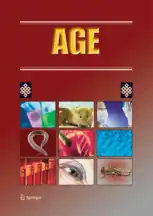GeroScience
GeroScience (formerly Age; Journal of the American Aging Association) is a premier bi-monthly, international, peer-reviewed journal that publishes cutting-edge research related to the biology of aging, pathophysiology of age-related diseases, and research on biomedical applications that impact aging and/or the pathogenesis of diseases associated with old age. GeroScience publishes manuscripts that cover the entire spectrum of Geroscience, ranging from basic science, translational and clinical research, to epidemiology and public health interventions, all centered around aging research.[1]
 | |
| Discipline | Aging |
|---|---|
| Language | English |
| Edited by | Zoltan Ungvari, MD, PhD, Veronica Galvan, PhD |
| Publication details | |
Former name(s) | Age, Journal of the American Aging Association |
| History | 1978–present |
| Publisher | |
| Frequency | Monthly |
| 7.581 (2021) | |
| Standard abbreviations | |
| ISO 4 | GeroScience |
| Indexing | |
| ISSN | 0161-9152 (print) 1574-4647 (web) |
| Links | |
Topics
As an interdisciplinary journal, GeroScience publishes manuscripts addressing questions related to the geroscience research using a broad spectrum of approaches, including experimental biogerontology, physiology and pathophysiology, molecular and cell biology, biochemistry, genetics, genomics, proteomics, epigenetics, cardiovascular medicine, geriatrics and gerontology, neuroscience, neurology, endocrinology, immunology, hematology, pharmacology, ophthalmology, complementary medicine (including studies on natural compounds in the context of aging research), veterinary sciences (including veterinary pathology), virology (e.g. relevant aspects of the COVID-19 pandemics), epidemiology, public health, and psychology. In line with the strategic directions of the National Institute on Aging, GeroScience also prioritizes publishing cutting-edge research on Alzheimer's Disease and Related Dementias (AD/ADRD), including vascular cognitive impairment and dementia (VCID). Manuscripts that develop innovative pharmacological, genetic, or nutritional strategies to improve cardiovascular, neurocognitive, and musculoskeletal health-span are of high importance. The journal regularly publishes comprehensive reviews of critical topics in geroscience research. The journal's editorial board consists of internationally recognized leaders in their respective fields, representing the focus areas of the journal. GeroScience is currently ranked #4/99 in Geriatrics and Gerontology, #1/86 in Complementary and Alternative Medicine, #5/35 in Biochemistry, Genetics and Molecular Biology/Aging, #1/16 in Veterinary medicine and #21/317 in Cardiology and Cardiovascular Medicine.[2] The 2020 CiteScore value of GeroScience is 9.5 (Elsevier/Scopus). The 2021 Impact Factor of GeroScience is 7.581 (Clarivate Analytics). The current list of open Call-for-Papers (including “Bridging Geroscience and Neuroscience: Exploring Neurosurgical and Neurological Perspectives on Aging and Age-Related Diseases"; "Enhancing health span through anti-aging dietary interventions"; "Animal Models for Translational and Preclinical Geroscience Research"; "Advances in Neurostimulation in Aging: From Basic Science to Clinical Applications"; "Cell Biology of Vascular Aging"; "Reproductive Aging"; "Aging in Companion Animals"; “Understanding and overcoming the mechanisms driving age-related sarcopenia“; “Understanding Senescence in Brain Aging and Alzheimer's Disease “ ; “White matter lesions in age-related cognitive decline: etiology, risk factors, prevention and repair“) can be accessed at the journal's website. [3]
Management
It is published by Springer Science+Business Media. The editor-in-Chiefs are Zoltan Ungvari, MD, PhD and Veronica Galvan, PhD. Deputy Editors are Stefano Tarantini, PhD and Holly Brown-Borg, PhD.[4]
References
- "American Aging Association". American Aging Association. Retrieved 2018-05-14.
- "Scopus - GeroScience data". Retrieved 8 August 2021.
- "Call-for-Papers". Retrieved 15 November 2021.
- "GeroScience. Details Page: Editorial Board". Springer. Retrieved 14 May 2018.